INF70005 Strategic Project Management: Research Report, Sem 1, 2018
VerifiedAdded on 2024/06/03
|9
|4260
|438
Report
AI Summary
This report reflects on experiences and learning within a strategic project management context, specifically focusing on team dynamics and communication challenges. The author, acting as a project manager, identifies key issues such as communication breakdowns and skill gaps within the team. The report discusses the application of communication theories—Rhetorical, Semiotic, and Development Communication—to address these challenges. It highlights the importance of understanding team member diversity and managing both positive and negative team dynamics. The reflection includes insights gained from international speakers on project management and details how these learnings can be applied to improve future project outcomes, emphasizing the need for effective communication and skill development within project teams. The document is submitted by a student and available on Desklib.
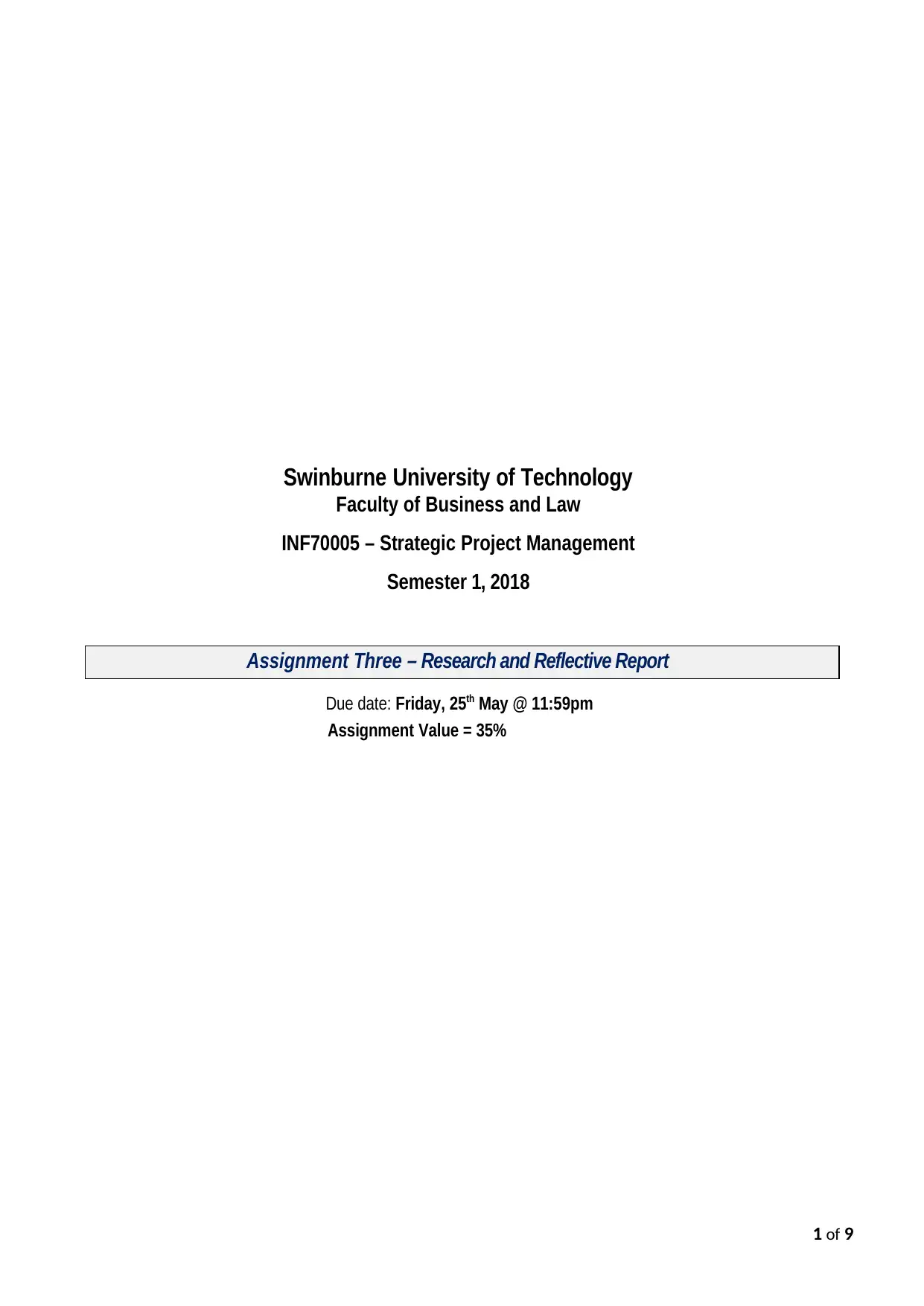
Swinburne University of Technology
Faculty of Business and Law
INF70005 – Strategic Project Management
Semester 1, 2018
Assignment Three – Research and Reflective Report
Due date: Friday, 25th May @ 11:59pm
Assignment Value = 35%
1 of 9
Faculty of Business and Law
INF70005 – Strategic Project Management
Semester 1, 2018
Assignment Three – Research and Reflective Report
Due date: Friday, 25th May @ 11:59pm
Assignment Value = 35%
1 of 9
Paraphrase This Document
Need a fresh take? Get an instant paraphrase of this document with our AI Paraphraser

Your Name: Your student ID: (use this template for Assignment 3)
Issue / Concept Specific aspect / area of focus Your response Grade & comments
Introduction Introduction to your project team
and your role within it.
[50 – 100 words]
The report will be prepared for the issues of project management and I will be
working as a project manager to identify all the concerns that are raised at the
time of working as a team. The concepts of project management will be
discussed along with the team member dynamics. Significance, aims and the
objectives of the project management will be discussed and the team dynamics
will be identified.
/2
Project management
concepts
Comment on the project
significance, aims, and objectives
and what you have learned from this
experience.
[100 words]
The chief aims of the project are to comprehend about the issues of project
management and a discussion will be laid on the concepts of project
management so that the issues can be identified and the theories can be
developed and learned to know about the solution of that issues. After
completion of the project, the ways in which project in a team is carried out and
the diverse impacts the project can put on the team will be discussed. The
utilisations of theories on the management of the team were developed to gain
the perfect experience about the team dynamics. /4Identify and explain one or two key
problem[s]/risk[s] encountered and
describe your response and why
that approach was chosen.
[100 words]
Some of the significant problems that were raised at the time of project
management were of improper communication and team skills. As a project
manager, I just documented the core skills that were needed to be
accomplished. I also analyzed the strengths and weaknesses of the team
members so that the poor parts could be enhanced and new skills can be
developed. I can also determine the flows in communication and try to develop
different ways to transfer that data to the other members and make them
informed about the new project.
Team member dynamics Explain what team dynamics
worked well during the semester
and why. What insights will you take
into future projects?
[100 words]
The team dynamics functioned very well at the time of semester due to a proper
understanding of the cultures and backgrounds of the other team members. The
team members were great at managing the risks and had plentiful of skills for
defining and fulfilling the goals at the desired time. The future project
management can be enhanced by efficient communication among the team
members and utilization of most suited tools for project management. The future
projects can also be enhanced and carried out successfully by noting down all
the essentials of the project on paper and generating knowledge about the skills
of the team associates.
/4
Identify one or two key team
dynamics [positive or negative]
which impacted your team’s
performance?
Team dynamics can stimulus the presentation of the team and the organization
in both positive and negative ways. In the team, poor team dynamics can hinder
the growth-affecting it negatively. As all the team members try to solve their
problems on their own it leads to an unhealthy team which avoids the proper
2 of 9
Issue / Concept Specific aspect / area of focus Your response Grade & comments
Introduction Introduction to your project team
and your role within it.
[50 – 100 words]
The report will be prepared for the issues of project management and I will be
working as a project manager to identify all the concerns that are raised at the
time of working as a team. The concepts of project management will be
discussed along with the team member dynamics. Significance, aims and the
objectives of the project management will be discussed and the team dynamics
will be identified.
/2
Project management
concepts
Comment on the project
significance, aims, and objectives
and what you have learned from this
experience.
[100 words]
The chief aims of the project are to comprehend about the issues of project
management and a discussion will be laid on the concepts of project
management so that the issues can be identified and the theories can be
developed and learned to know about the solution of that issues. After
completion of the project, the ways in which project in a team is carried out and
the diverse impacts the project can put on the team will be discussed. The
utilisations of theories on the management of the team were developed to gain
the perfect experience about the team dynamics. /4Identify and explain one or two key
problem[s]/risk[s] encountered and
describe your response and why
that approach was chosen.
[100 words]
Some of the significant problems that were raised at the time of project
management were of improper communication and team skills. As a project
manager, I just documented the core skills that were needed to be
accomplished. I also analyzed the strengths and weaknesses of the team
members so that the poor parts could be enhanced and new skills can be
developed. I can also determine the flows in communication and try to develop
different ways to transfer that data to the other members and make them
informed about the new project.
Team member dynamics Explain what team dynamics
worked well during the semester
and why. What insights will you take
into future projects?
[100 words]
The team dynamics functioned very well at the time of semester due to a proper
understanding of the cultures and backgrounds of the other team members. The
team members were great at managing the risks and had plentiful of skills for
defining and fulfilling the goals at the desired time. The future project
management can be enhanced by efficient communication among the team
members and utilization of most suited tools for project management. The future
projects can also be enhanced and carried out successfully by noting down all
the essentials of the project on paper and generating knowledge about the skills
of the team associates.
/4
Identify one or two key team
dynamics [positive or negative]
which impacted your team’s
performance?
Team dynamics can stimulus the presentation of the team and the organization
in both positive and negative ways. In the team, poor team dynamics can hinder
the growth-affecting it negatively. As all the team members try to solve their
problems on their own it leads to an unhealthy team which avoids the proper
2 of 9
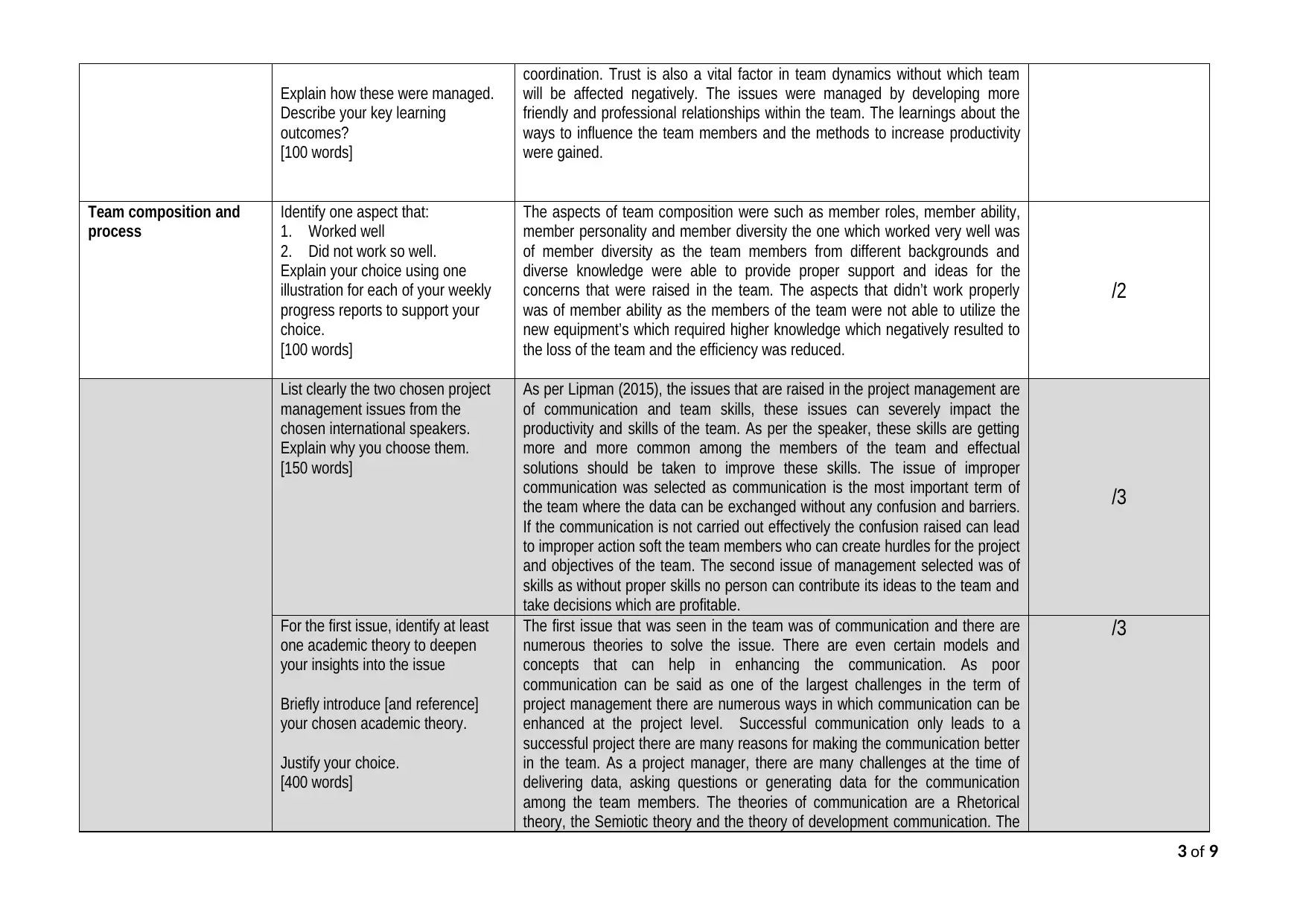
Explain how these were managed.
Describe your key learning
outcomes?
[100 words]
coordination. Trust is also a vital factor in team dynamics without which team
will be affected negatively. The issues were managed by developing more
friendly and professional relationships within the team. The learnings about the
ways to influence the team members and the methods to increase productivity
were gained.
Team composition and
process
Identify one aspect that:
1. Worked well
2. Did not work so well.
Explain your choice using one
illustration for each of your weekly
progress reports to support your
choice.
[100 words]
The aspects of team composition were such as member roles, member ability,
member personality and member diversity the one which worked very well was
of member diversity as the team members from different backgrounds and
diverse knowledge were able to provide proper support and ideas for the
concerns that were raised in the team. The aspects that didn’t work properly
was of member ability as the members of the team were not able to utilize the
new equipment’s which required higher knowledge which negatively resulted to
the loss of the team and the efficiency was reduced.
/2
List clearly the two chosen project
management issues from the
chosen international speakers.
Explain why you choose them.
[150 words]
As per Lipman (2015), the issues that are raised in the project management are
of communication and team skills, these issues can severely impact the
productivity and skills of the team. As per the speaker, these skills are getting
more and more common among the members of the team and effectual
solutions should be taken to improve these skills. The issue of improper
communication was selected as communication is the most important term of
the team where the data can be exchanged without any confusion and barriers.
If the communication is not carried out effectively the confusion raised can lead
to improper action soft the team members who can create hurdles for the project
and objectives of the team. The second issue of management selected was of
skills as without proper skills no person can contribute its ideas to the team and
take decisions which are profitable.
/3
For the first issue, identify at least
one academic theory to deepen
your insights into the issue
Briefly introduce [and reference]
your chosen academic theory.
Justify your choice.
[400 words]
The first issue that was seen in the team was of communication and there are
numerous theories to solve the issue. There are even certain models and
concepts that can help in enhancing the communication. As poor
communication can be said as one of the largest challenges in the term of
project management there are numerous ways in which communication can be
enhanced at the project level. Successful communication only leads to a
successful project there are many reasons for making the communication better
in the team. As a project manager, there are many challenges at the time of
delivering data, asking questions or generating data for the communication
among the team members. The theories of communication are a Rhetorical
theory, the Semiotic theory and the theory of development communication. The
/3
3 of 9
Describe your key learning
outcomes?
[100 words]
coordination. Trust is also a vital factor in team dynamics without which team
will be affected negatively. The issues were managed by developing more
friendly and professional relationships within the team. The learnings about the
ways to influence the team members and the methods to increase productivity
were gained.
Team composition and
process
Identify one aspect that:
1. Worked well
2. Did not work so well.
Explain your choice using one
illustration for each of your weekly
progress reports to support your
choice.
[100 words]
The aspects of team composition were such as member roles, member ability,
member personality and member diversity the one which worked very well was
of member diversity as the team members from different backgrounds and
diverse knowledge were able to provide proper support and ideas for the
concerns that were raised in the team. The aspects that didn’t work properly
was of member ability as the members of the team were not able to utilize the
new equipment’s which required higher knowledge which negatively resulted to
the loss of the team and the efficiency was reduced.
/2
List clearly the two chosen project
management issues from the
chosen international speakers.
Explain why you choose them.
[150 words]
As per Lipman (2015), the issues that are raised in the project management are
of communication and team skills, these issues can severely impact the
productivity and skills of the team. As per the speaker, these skills are getting
more and more common among the members of the team and effectual
solutions should be taken to improve these skills. The issue of improper
communication was selected as communication is the most important term of
the team where the data can be exchanged without any confusion and barriers.
If the communication is not carried out effectively the confusion raised can lead
to improper action soft the team members who can create hurdles for the project
and objectives of the team. The second issue of management selected was of
skills as without proper skills no person can contribute its ideas to the team and
take decisions which are profitable.
/3
For the first issue, identify at least
one academic theory to deepen
your insights into the issue
Briefly introduce [and reference]
your chosen academic theory.
Justify your choice.
[400 words]
The first issue that was seen in the team was of communication and there are
numerous theories to solve the issue. There are even certain models and
concepts that can help in enhancing the communication. As poor
communication can be said as one of the largest challenges in the term of
project management there are numerous ways in which communication can be
enhanced at the project level. Successful communication only leads to a
successful project there are many reasons for making the communication better
in the team. As a project manager, there are many challenges at the time of
delivering data, asking questions or generating data for the communication
among the team members. The theories of communication are a Rhetorical
theory, the Semiotic theory and the theory of development communication. The
/3
3 of 9
⊘ This is a preview!⊘
Do you want full access?
Subscribe today to unlock all pages.

Trusted by 1+ million students worldwide
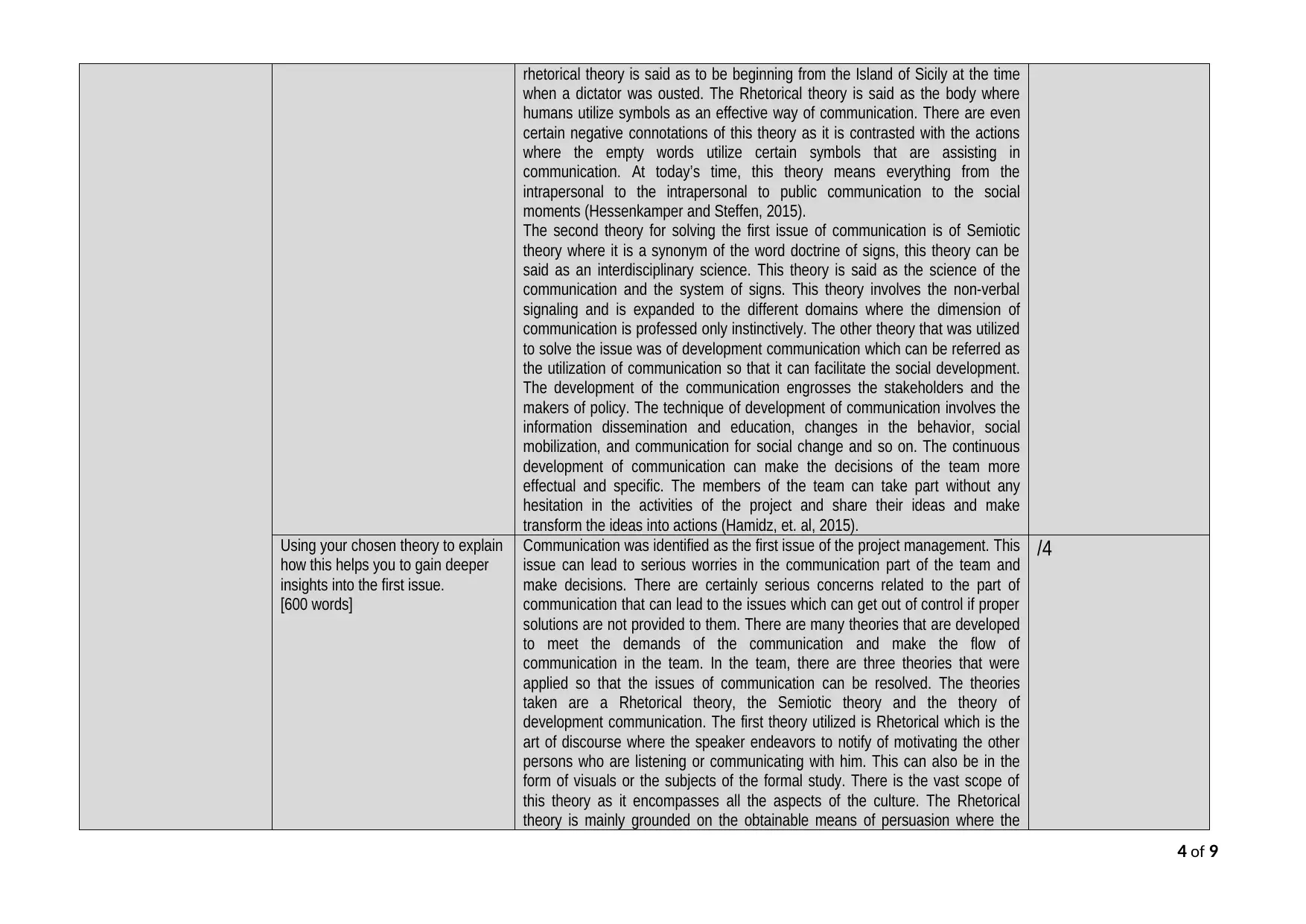
rhetorical theory is said as to be beginning from the Island of Sicily at the time
when a dictator was ousted. The Rhetorical theory is said as the body where
humans utilize symbols as an effective way of communication. There are even
certain negative connotations of this theory as it is contrasted with the actions
where the empty words utilize certain symbols that are assisting in
communication. At today’s time, this theory means everything from the
intrapersonal to the intrapersonal to public communication to the social
moments (Hessenkamper and Steffen, 2015).
The second theory for solving the first issue of communication is of Semiotic
theory where it is a synonym of the word doctrine of signs, this theory can be
said as an interdisciplinary science. This theory is said as the science of the
communication and the system of signs. This theory involves the non-verbal
signaling and is expanded to the different domains where the dimension of
communication is professed only instinctively. The other theory that was utilized
to solve the issue was of development communication which can be referred as
the utilization of communication so that it can facilitate the social development.
The development of the communication engrosses the stakeholders and the
makers of policy. The technique of development of communication involves the
information dissemination and education, changes in the behavior, social
mobilization, and communication for social change and so on. The continuous
development of communication can make the decisions of the team more
effectual and specific. The members of the team can take part without any
hesitation in the activities of the project and share their ideas and make
transform the ideas into actions (Hamidz, et. al, 2015).
Using your chosen theory to explain
how this helps you to gain deeper
insights into the first issue.
[600 words]
Communication was identified as the first issue of the project management. This
issue can lead to serious worries in the communication part of the team and
make decisions. There are certainly serious concerns related to the part of
communication that can lead to the issues which can get out of control if proper
solutions are not provided to them. There are many theories that are developed
to meet the demands of the communication and make the flow of
communication in the team. In the team, there are three theories that were
applied so that the issues of communication can be resolved. The theories
taken are a Rhetorical theory, the Semiotic theory and the theory of
development communication. The first theory utilized is Rhetorical which is the
art of discourse where the speaker endeavors to notify of motivating the other
persons who are listening or communicating with him. This can also be in the
form of visuals or the subjects of the formal study. There is the vast scope of
this theory as it encompasses all the aspects of the culture. The Rhetorical
theory is mainly grounded on the obtainable means of persuasion where the
/4
4 of 9
when a dictator was ousted. The Rhetorical theory is said as the body where
humans utilize symbols as an effective way of communication. There are even
certain negative connotations of this theory as it is contrasted with the actions
where the empty words utilize certain symbols that are assisting in
communication. At today’s time, this theory means everything from the
intrapersonal to the intrapersonal to public communication to the social
moments (Hessenkamper and Steffen, 2015).
The second theory for solving the first issue of communication is of Semiotic
theory where it is a synonym of the word doctrine of signs, this theory can be
said as an interdisciplinary science. This theory is said as the science of the
communication and the system of signs. This theory involves the non-verbal
signaling and is expanded to the different domains where the dimension of
communication is professed only instinctively. The other theory that was utilized
to solve the issue was of development communication which can be referred as
the utilization of communication so that it can facilitate the social development.
The development of the communication engrosses the stakeholders and the
makers of policy. The technique of development of communication involves the
information dissemination and education, changes in the behavior, social
mobilization, and communication for social change and so on. The continuous
development of communication can make the decisions of the team more
effectual and specific. The members of the team can take part without any
hesitation in the activities of the project and share their ideas and make
transform the ideas into actions (Hamidz, et. al, 2015).
Using your chosen theory to explain
how this helps you to gain deeper
insights into the first issue.
[600 words]
Communication was identified as the first issue of the project management. This
issue can lead to serious worries in the communication part of the team and
make decisions. There are certainly serious concerns related to the part of
communication that can lead to the issues which can get out of control if proper
solutions are not provided to them. There are many theories that are developed
to meet the demands of the communication and make the flow of
communication in the team. In the team, there are three theories that were
applied so that the issues of communication can be resolved. The theories
taken are a Rhetorical theory, the Semiotic theory and the theory of
development communication. The first theory utilized is Rhetorical which is the
art of discourse where the speaker endeavors to notify of motivating the other
persons who are listening or communicating with him. This can also be in the
form of visuals or the subjects of the formal study. There is the vast scope of
this theory as it encompasses all the aspects of the culture. The Rhetorical
theory is mainly grounded on the obtainable means of persuasion where the
/4
4 of 9
Paraphrase This Document
Need a fresh take? Get an instant paraphrase of this document with our AI Paraphraser
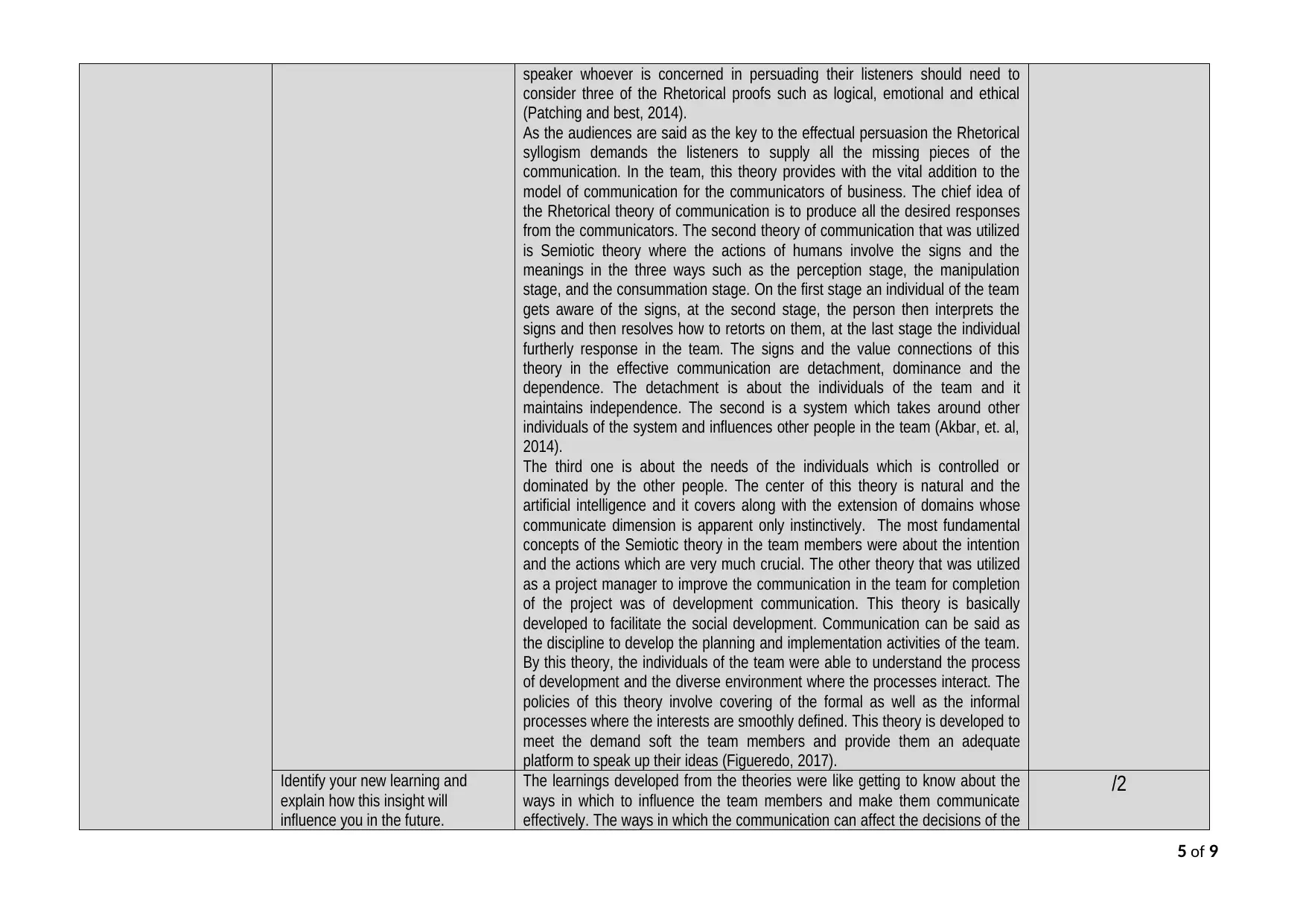
speaker whoever is concerned in persuading their listeners should need to
consider three of the Rhetorical proofs such as logical, emotional and ethical
(Patching and best, 2014).
As the audiences are said as the key to the effectual persuasion the Rhetorical
syllogism demands the listeners to supply all the missing pieces of the
communication. In the team, this theory provides with the vital addition to the
model of communication for the communicators of business. The chief idea of
the Rhetorical theory of communication is to produce all the desired responses
from the communicators. The second theory of communication that was utilized
is Semiotic theory where the actions of humans involve the signs and the
meanings in the three ways such as the perception stage, the manipulation
stage, and the consummation stage. On the first stage an individual of the team
gets aware of the signs, at the second stage, the person then interprets the
signs and then resolves how to retorts on them, at the last stage the individual
furtherly response in the team. The signs and the value connections of this
theory in the effective communication are detachment, dominance and the
dependence. The detachment is about the individuals of the team and it
maintains independence. The second is a system which takes around other
individuals of the system and influences other people in the team (Akbar, et. al,
2014).
The third one is about the needs of the individuals which is controlled or
dominated by the other people. The center of this theory is natural and the
artificial intelligence and it covers along with the extension of domains whose
communicate dimension is apparent only instinctively. The most fundamental
concepts of the Semiotic theory in the team members were about the intention
and the actions which are very much crucial. The other theory that was utilized
as a project manager to improve the communication in the team for completion
of the project was of development communication. This theory is basically
developed to facilitate the social development. Communication can be said as
the discipline to develop the planning and implementation activities of the team.
By this theory, the individuals of the team were able to understand the process
of development and the diverse environment where the processes interact. The
policies of this theory involve covering of the formal as well as the informal
processes where the interests are smoothly defined. This theory is developed to
meet the demand soft the team members and provide them an adequate
platform to speak up their ideas (Figueredo, 2017).
Identify your new learning and
explain how this insight will
influence you in the future.
The learnings developed from the theories were like getting to know about the
ways in which to influence the team members and make them communicate
effectively. The ways in which the communication can affect the decisions of the
/2
5 of 9
consider three of the Rhetorical proofs such as logical, emotional and ethical
(Patching and best, 2014).
As the audiences are said as the key to the effectual persuasion the Rhetorical
syllogism demands the listeners to supply all the missing pieces of the
communication. In the team, this theory provides with the vital addition to the
model of communication for the communicators of business. The chief idea of
the Rhetorical theory of communication is to produce all the desired responses
from the communicators. The second theory of communication that was utilized
is Semiotic theory where the actions of humans involve the signs and the
meanings in the three ways such as the perception stage, the manipulation
stage, and the consummation stage. On the first stage an individual of the team
gets aware of the signs, at the second stage, the person then interprets the
signs and then resolves how to retorts on them, at the last stage the individual
furtherly response in the team. The signs and the value connections of this
theory in the effective communication are detachment, dominance and the
dependence. The detachment is about the individuals of the team and it
maintains independence. The second is a system which takes around other
individuals of the system and influences other people in the team (Akbar, et. al,
2014).
The third one is about the needs of the individuals which is controlled or
dominated by the other people. The center of this theory is natural and the
artificial intelligence and it covers along with the extension of domains whose
communicate dimension is apparent only instinctively. The most fundamental
concepts of the Semiotic theory in the team members were about the intention
and the actions which are very much crucial. The other theory that was utilized
as a project manager to improve the communication in the team for completion
of the project was of development communication. This theory is basically
developed to facilitate the social development. Communication can be said as
the discipline to develop the planning and implementation activities of the team.
By this theory, the individuals of the team were able to understand the process
of development and the diverse environment where the processes interact. The
policies of this theory involve covering of the formal as well as the informal
processes where the interests are smoothly defined. This theory is developed to
meet the demand soft the team members and provide them an adequate
platform to speak up their ideas (Figueredo, 2017).
Identify your new learning and
explain how this insight will
influence you in the future.
The learnings developed from the theories were like getting to know about the
ways in which to influence the team members and make them communicate
effectively. The ways in which the communication can affect the decisions of the
/2
5 of 9
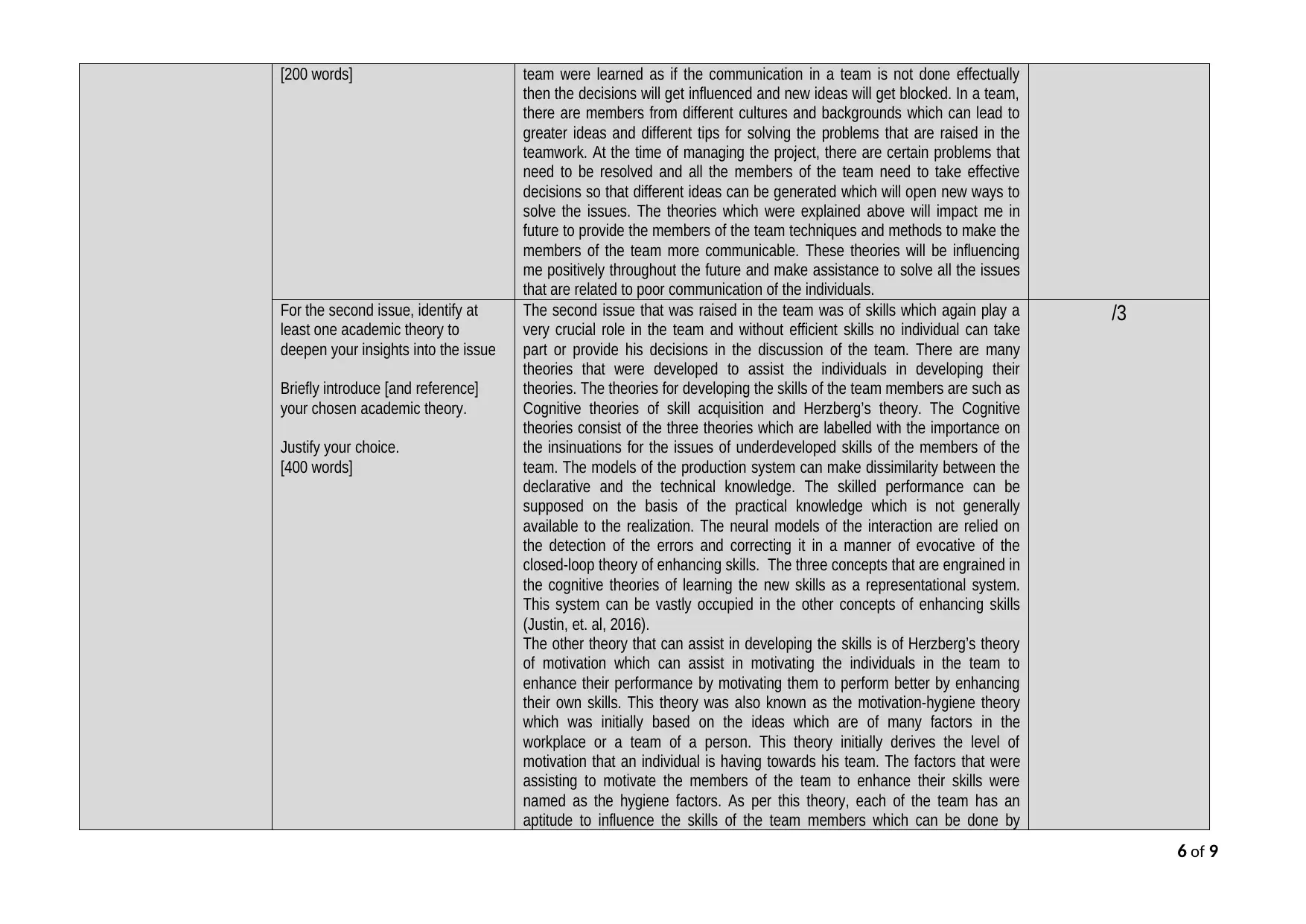
[200 words] team were learned as if the communication in a team is not done effectually
then the decisions will get influenced and new ideas will get blocked. In a team,
there are members from different cultures and backgrounds which can lead to
greater ideas and different tips for solving the problems that are raised in the
teamwork. At the time of managing the project, there are certain problems that
need to be resolved and all the members of the team need to take effective
decisions so that different ideas can be generated which will open new ways to
solve the issues. The theories which were explained above will impact me in
future to provide the members of the team techniques and methods to make the
members of the team more communicable. These theories will be influencing
me positively throughout the future and make assistance to solve all the issues
that are related to poor communication of the individuals.
For the second issue, identify at
least one academic theory to
deepen your insights into the issue
Briefly introduce [and reference]
your chosen academic theory.
Justify your choice.
[400 words]
The second issue that was raised in the team was of skills which again play a
very crucial role in the team and without efficient skills no individual can take
part or provide his decisions in the discussion of the team. There are many
theories that were developed to assist the individuals in developing their
theories. The theories for developing the skills of the team members are such as
Cognitive theories of skill acquisition and Herzberg’s theory. The Cognitive
theories consist of the three theories which are labelled with the importance on
the insinuations for the issues of underdeveloped skills of the members of the
team. The models of the production system can make dissimilarity between the
declarative and the technical knowledge. The skilled performance can be
supposed on the basis of the practical knowledge which is not generally
available to the realization. The neural models of the interaction are relied on
the detection of the errors and correcting it in a manner of evocative of the
closed-loop theory of enhancing skills. The three concepts that are engrained in
the cognitive theories of learning the new skills as a representational system.
This system can be vastly occupied in the other concepts of enhancing skills
(Justin, et. al, 2016).
The other theory that can assist in developing the skills is of Herzberg’s theory
of motivation which can assist in motivating the individuals in the team to
enhance their performance by motivating them to perform better by enhancing
their own skills. This theory was also known as the motivation-hygiene theory
which was initially based on the ideas which are of many factors in the
workplace or a team of a person. This theory initially derives the level of
motivation that an individual is having towards his team. The factors that were
assisting to motivate the members of the team to enhance their skills were
named as the hygiene factors. As per this theory, each of the team has an
aptitude to influence the skills of the team members which can be done by
/3
6 of 9
then the decisions will get influenced and new ideas will get blocked. In a team,
there are members from different cultures and backgrounds which can lead to
greater ideas and different tips for solving the problems that are raised in the
teamwork. At the time of managing the project, there are certain problems that
need to be resolved and all the members of the team need to take effective
decisions so that different ideas can be generated which will open new ways to
solve the issues. The theories which were explained above will impact me in
future to provide the members of the team techniques and methods to make the
members of the team more communicable. These theories will be influencing
me positively throughout the future and make assistance to solve all the issues
that are related to poor communication of the individuals.
For the second issue, identify at
least one academic theory to
deepen your insights into the issue
Briefly introduce [and reference]
your chosen academic theory.
Justify your choice.
[400 words]
The second issue that was raised in the team was of skills which again play a
very crucial role in the team and without efficient skills no individual can take
part or provide his decisions in the discussion of the team. There are many
theories that were developed to assist the individuals in developing their
theories. The theories for developing the skills of the team members are such as
Cognitive theories of skill acquisition and Herzberg’s theory. The Cognitive
theories consist of the three theories which are labelled with the importance on
the insinuations for the issues of underdeveloped skills of the members of the
team. The models of the production system can make dissimilarity between the
declarative and the technical knowledge. The skilled performance can be
supposed on the basis of the practical knowledge which is not generally
available to the realization. The neural models of the interaction are relied on
the detection of the errors and correcting it in a manner of evocative of the
closed-loop theory of enhancing skills. The three concepts that are engrained in
the cognitive theories of learning the new skills as a representational system.
This system can be vastly occupied in the other concepts of enhancing skills
(Justin, et. al, 2016).
The other theory that can assist in developing the skills is of Herzberg’s theory
of motivation which can assist in motivating the individuals in the team to
enhance their performance by motivating them to perform better by enhancing
their own skills. This theory was also known as the motivation-hygiene theory
which was initially based on the ideas which are of many factors in the
workplace or a team of a person. This theory initially derives the level of
motivation that an individual is having towards his team. The factors that were
assisting to motivate the members of the team to enhance their skills were
named as the hygiene factors. As per this theory, each of the team has an
aptitude to influence the skills of the team members which can be done by
/3
6 of 9
⊘ This is a preview!⊘
Do you want full access?
Subscribe today to unlock all pages.

Trusted by 1+ million students worldwide
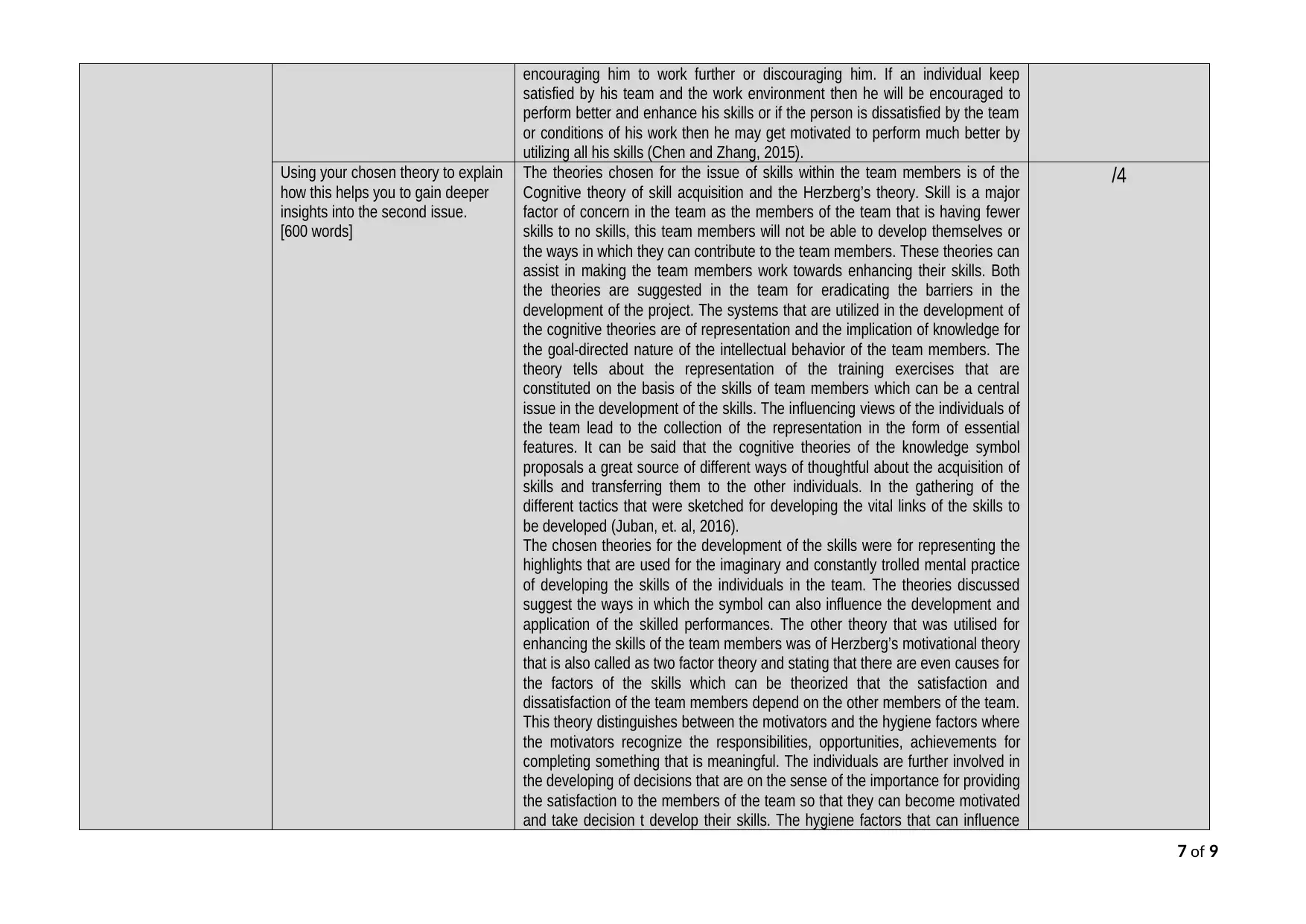
encouraging him to work further or discouraging him. If an individual keep
satisfied by his team and the work environment then he will be encouraged to
perform better and enhance his skills or if the person is dissatisfied by the team
or conditions of his work then he may get motivated to perform much better by
utilizing all his skills (Chen and Zhang, 2015).
Using your chosen theory to explain
how this helps you to gain deeper
insights into the second issue.
[600 words]
The theories chosen for the issue of skills within the team members is of the
Cognitive theory of skill acquisition and the Herzberg’s theory. Skill is a major
factor of concern in the team as the members of the team that is having fewer
skills to no skills, this team members will not be able to develop themselves or
the ways in which they can contribute to the team members. These theories can
assist in making the team members work towards enhancing their skills. Both
the theories are suggested in the team for eradicating the barriers in the
development of the project. The systems that are utilized in the development of
the cognitive theories are of representation and the implication of knowledge for
the goal-directed nature of the intellectual behavior of the team members. The
theory tells about the representation of the training exercises that are
constituted on the basis of the skills of team members which can be a central
issue in the development of the skills. The influencing views of the individuals of
the team lead to the collection of the representation in the form of essential
features. It can be said that the cognitive theories of the knowledge symbol
proposals a great source of different ways of thoughtful about the acquisition of
skills and transferring them to the other individuals. In the gathering of the
different tactics that were sketched for developing the vital links of the skills to
be developed (Juban, et. al, 2016).
The chosen theories for the development of the skills were for representing the
highlights that are used for the imaginary and constantly trolled mental practice
of developing the skills of the individuals in the team. The theories discussed
suggest the ways in which the symbol can also influence the development and
application of the skilled performances. The other theory that was utilised for
enhancing the skills of the team members was of Herzberg’s motivational theory
that is also called as two factor theory and stating that there are even causes for
the factors of the skills which can be theorized that the satisfaction and
dissatisfaction of the team members depend on the other members of the team.
This theory distinguishes between the motivators and the hygiene factors where
the motivators recognize the responsibilities, opportunities, achievements for
completing something that is meaningful. The individuals are further involved in
the developing of decisions that are on the sense of the importance for providing
the satisfaction to the members of the team so that they can become motivated
and take decision t develop their skills. The hygiene factors that can influence
/4
7 of 9
satisfied by his team and the work environment then he will be encouraged to
perform better and enhance his skills or if the person is dissatisfied by the team
or conditions of his work then he may get motivated to perform much better by
utilizing all his skills (Chen and Zhang, 2015).
Using your chosen theory to explain
how this helps you to gain deeper
insights into the second issue.
[600 words]
The theories chosen for the issue of skills within the team members is of the
Cognitive theory of skill acquisition and the Herzberg’s theory. Skill is a major
factor of concern in the team as the members of the team that is having fewer
skills to no skills, this team members will not be able to develop themselves or
the ways in which they can contribute to the team members. These theories can
assist in making the team members work towards enhancing their skills. Both
the theories are suggested in the team for eradicating the barriers in the
development of the project. The systems that are utilized in the development of
the cognitive theories are of representation and the implication of knowledge for
the goal-directed nature of the intellectual behavior of the team members. The
theory tells about the representation of the training exercises that are
constituted on the basis of the skills of team members which can be a central
issue in the development of the skills. The influencing views of the individuals of
the team lead to the collection of the representation in the form of essential
features. It can be said that the cognitive theories of the knowledge symbol
proposals a great source of different ways of thoughtful about the acquisition of
skills and transferring them to the other individuals. In the gathering of the
different tactics that were sketched for developing the vital links of the skills to
be developed (Juban, et. al, 2016).
The chosen theories for the development of the skills were for representing the
highlights that are used for the imaginary and constantly trolled mental practice
of developing the skills of the individuals in the team. The theories discussed
suggest the ways in which the symbol can also influence the development and
application of the skilled performances. The other theory that was utilised for
enhancing the skills of the team members was of Herzberg’s motivational theory
that is also called as two factor theory and stating that there are even causes for
the factors of the skills which can be theorized that the satisfaction and
dissatisfaction of the team members depend on the other members of the team.
This theory distinguishes between the motivators and the hygiene factors where
the motivators recognize the responsibilities, opportunities, achievements for
completing something that is meaningful. The individuals are further involved in
the developing of decisions that are on the sense of the importance for providing
the satisfaction to the members of the team so that they can become motivated
and take decision t develop their skills. The hygiene factors that can influence
/4
7 of 9
Paraphrase This Document
Need a fresh take? Get an instant paraphrase of this document with our AI Paraphraser
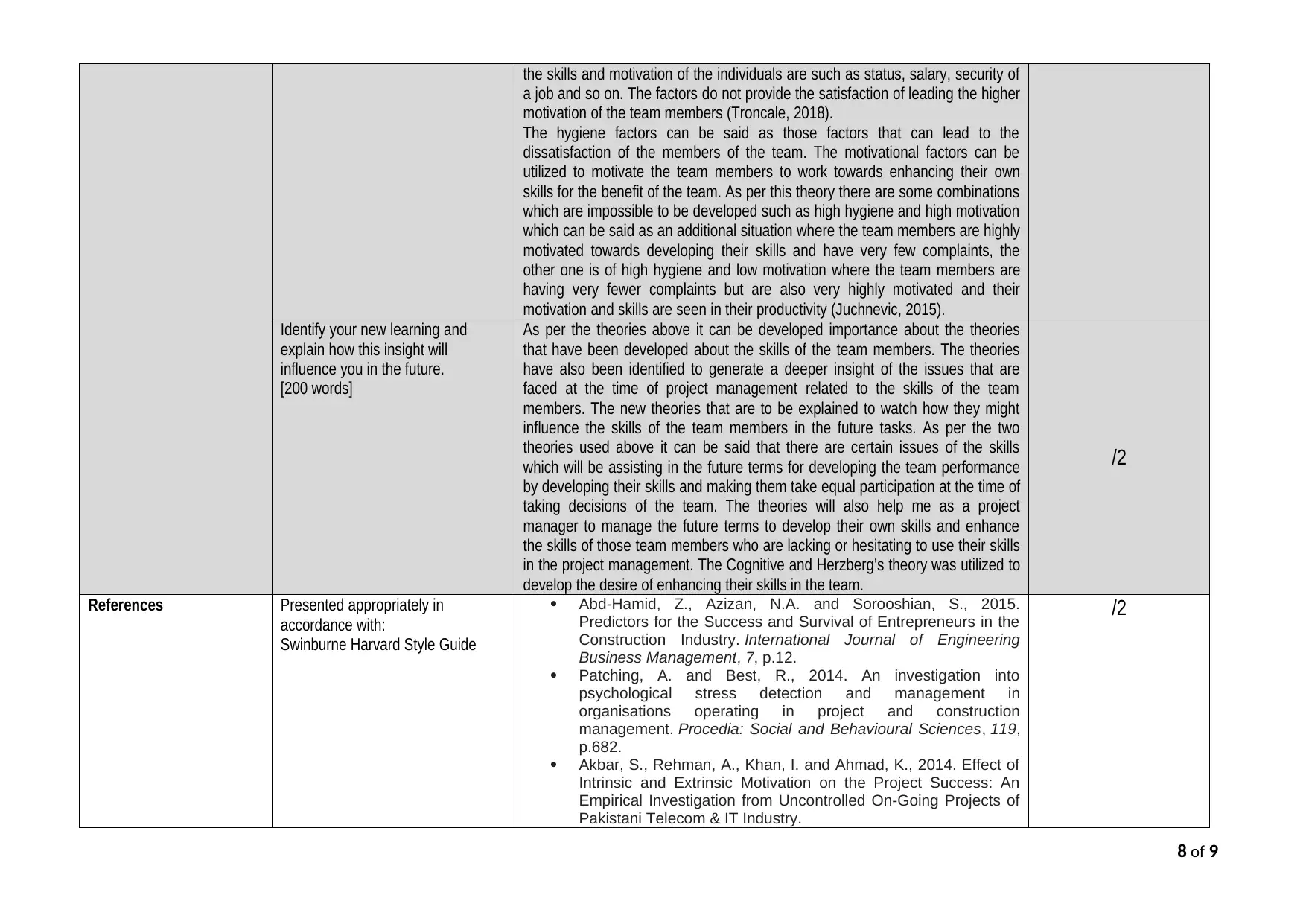
the skills and motivation of the individuals are such as status, salary, security of
a job and so on. The factors do not provide the satisfaction of leading the higher
motivation of the team members (Troncale, 2018).
The hygiene factors can be said as those factors that can lead to the
dissatisfaction of the members of the team. The motivational factors can be
utilized to motivate the team members to work towards enhancing their own
skills for the benefit of the team. As per this theory there are some combinations
which are impossible to be developed such as high hygiene and high motivation
which can be said as an additional situation where the team members are highly
motivated towards developing their skills and have very few complaints, the
other one is of high hygiene and low motivation where the team members are
having very fewer complaints but are also very highly motivated and their
motivation and skills are seen in their productivity (Juchnevic, 2015).
Identify your new learning and
explain how this insight will
influence you in the future.
[200 words]
As per the theories above it can be developed importance about the theories
that have been developed about the skills of the team members. The theories
have also been identified to generate a deeper insight of the issues that are
faced at the time of project management related to the skills of the team
members. The new theories that are to be explained to watch how they might
influence the skills of the team members in the future tasks. As per the two
theories used above it can be said that there are certain issues of the skills
which will be assisting in the future terms for developing the team performance
by developing their skills and making them take equal participation at the time of
taking decisions of the team. The theories will also help me as a project
manager to manage the future terms to develop their own skills and enhance
the skills of those team members who are lacking or hesitating to use their skills
in the project management. The Cognitive and Herzberg’s theory was utilized to
develop the desire of enhancing their skills in the team.
/2
References Presented appropriately in
accordance with:
Swinburne Harvard Style Guide
Abd-Hamid, Z., Azizan, N.A. and Sorooshian, S., 2015.
Predictors for the Success and Survival of Entrepreneurs in the
Construction Industry. International Journal of Engineering
Business Management, 7, p.12.
Patching, A. and Best, R., 2014. An investigation into
psychological stress detection and management in
organisations operating in project and construction
management. Procedia: Social and Behavioural Sciences, 119,
p.682.
Akbar, S., Rehman, A., Khan, I. and Ahmad, K., 2014. Effect of
Intrinsic and Extrinsic Motivation on the Project Success: An
Empirical Investigation from Uncontrolled On-Going Projects of
Pakistani Telecom & IT Industry.
/2
8 of 9
a job and so on. The factors do not provide the satisfaction of leading the higher
motivation of the team members (Troncale, 2018).
The hygiene factors can be said as those factors that can lead to the
dissatisfaction of the members of the team. The motivational factors can be
utilized to motivate the team members to work towards enhancing their own
skills for the benefit of the team. As per this theory there are some combinations
which are impossible to be developed such as high hygiene and high motivation
which can be said as an additional situation where the team members are highly
motivated towards developing their skills and have very few complaints, the
other one is of high hygiene and low motivation where the team members are
having very fewer complaints but are also very highly motivated and their
motivation and skills are seen in their productivity (Juchnevic, 2015).
Identify your new learning and
explain how this insight will
influence you in the future.
[200 words]
As per the theories above it can be developed importance about the theories
that have been developed about the skills of the team members. The theories
have also been identified to generate a deeper insight of the issues that are
faced at the time of project management related to the skills of the team
members. The new theories that are to be explained to watch how they might
influence the skills of the team members in the future tasks. As per the two
theories used above it can be said that there are certain issues of the skills
which will be assisting in the future terms for developing the team performance
by developing their skills and making them take equal participation at the time of
taking decisions of the team. The theories will also help me as a project
manager to manage the future terms to develop their own skills and enhance
the skills of those team members who are lacking or hesitating to use their skills
in the project management. The Cognitive and Herzberg’s theory was utilized to
develop the desire of enhancing their skills in the team.
/2
References Presented appropriately in
accordance with:
Swinburne Harvard Style Guide
Abd-Hamid, Z., Azizan, N.A. and Sorooshian, S., 2015.
Predictors for the Success and Survival of Entrepreneurs in the
Construction Industry. International Journal of Engineering
Business Management, 7, p.12.
Patching, A. and Best, R., 2014. An investigation into
psychological stress detection and management in
organisations operating in project and construction
management. Procedia: Social and Behavioural Sciences, 119,
p.682.
Akbar, S., Rehman, A., Khan, I. and Ahmad, K., 2014. Effect of
Intrinsic and Extrinsic Motivation on the Project Success: An
Empirical Investigation from Uncontrolled On-Going Projects of
Pakistani Telecom & IT Industry.
/2
8 of 9
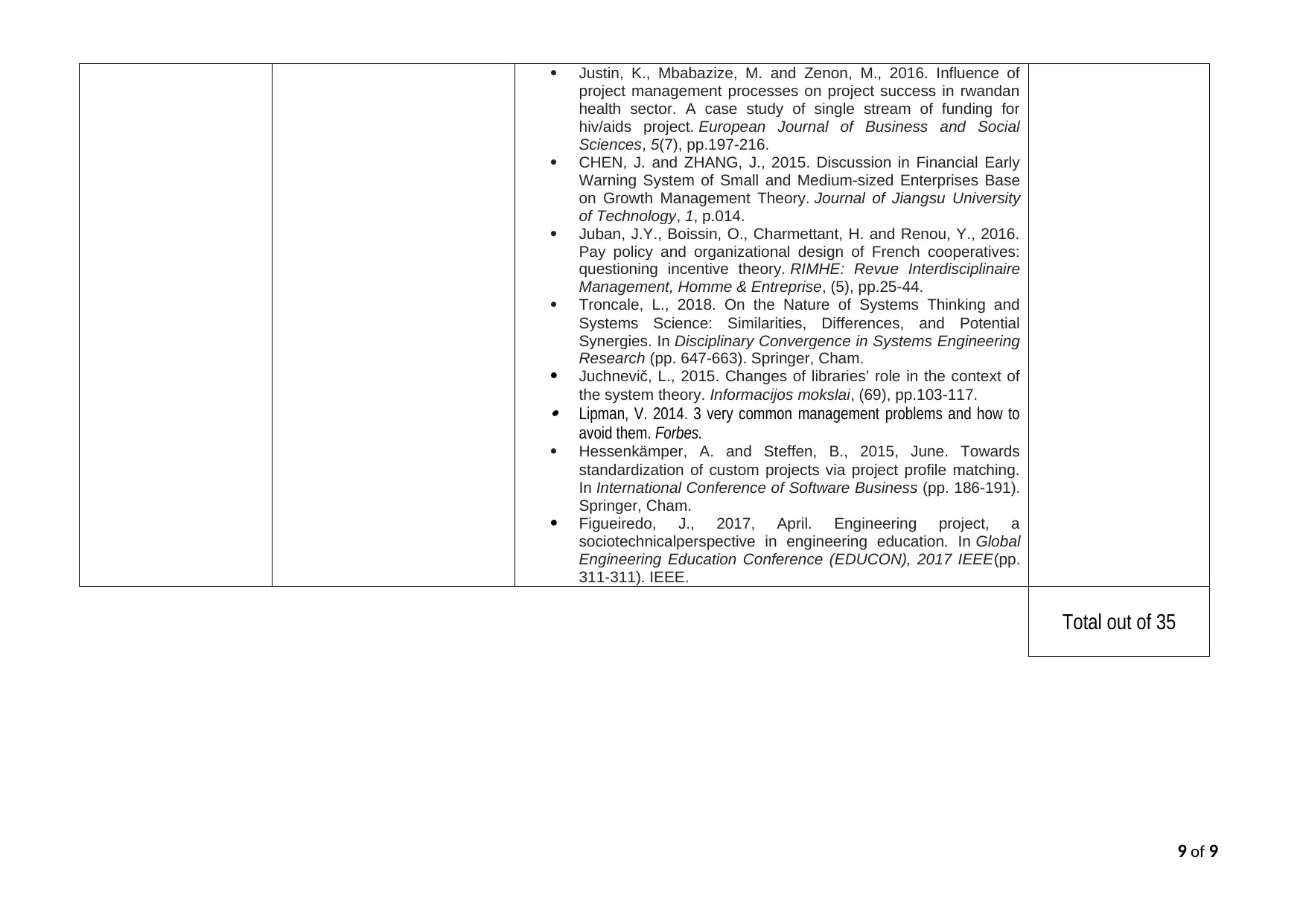
Justin, K., Mbabazize, M. and Zenon, M., 2016. Influence of
project management processes on project success in rwandan
health sector. A case study of single stream of funding for
hiv/aids project. European Journal of Business and Social
Sciences, 5(7), pp.197-216.
CHEN, J. and ZHANG, J., 2015. Discussion in Financial Early
Warning System of Small and Medium-sized Enterprises Base
on Growth Management Theory. Journal of Jiangsu University
of Technology, 1, p.014.
Juban, J.Y., Boissin, O., Charmettant, H. and Renou, Y., 2016.
Pay policy and organizational design of French cooperatives:
questioning incentive theory. RIMHE: Revue Interdisciplinaire
Management, Homme & Entreprise, (5), pp.25-44.
Troncale, L., 2018. On the Nature of Systems Thinking and
Systems Science: Similarities, Differences, and Potential
Synergies. In Disciplinary Convergence in Systems Engineering
Research (pp. 647-663). Springer, Cham.
Juchnevič, L., 2015. Changes of libraries’ role in the context of
the system theory. Informacijos mokslai, (69), pp.103-117.
Lipman, V. 2014. 3 very common management problems and how to
avoid them. Forbes.
Hessenkämper, A. and Steffen, B., 2015, June. Towards
standardization of custom projects via project profile matching.
In International Conference of Software Business (pp. 186-191).
Springer, Cham.
Figueiredo, J., 2017, April. Engineering project, a
sociotechnicalperspective in engineering education. In Global
Engineering Education Conference (EDUCON), 2017 IEEE(pp.
311-311). IEEE.
Total out of 35
9 of 9
project management processes on project success in rwandan
health sector. A case study of single stream of funding for
hiv/aids project. European Journal of Business and Social
Sciences, 5(7), pp.197-216.
CHEN, J. and ZHANG, J., 2015. Discussion in Financial Early
Warning System of Small and Medium-sized Enterprises Base
on Growth Management Theory. Journal of Jiangsu University
of Technology, 1, p.014.
Juban, J.Y., Boissin, O., Charmettant, H. and Renou, Y., 2016.
Pay policy and organizational design of French cooperatives:
questioning incentive theory. RIMHE: Revue Interdisciplinaire
Management, Homme & Entreprise, (5), pp.25-44.
Troncale, L., 2018. On the Nature of Systems Thinking and
Systems Science: Similarities, Differences, and Potential
Synergies. In Disciplinary Convergence in Systems Engineering
Research (pp. 647-663). Springer, Cham.
Juchnevič, L., 2015. Changes of libraries’ role in the context of
the system theory. Informacijos mokslai, (69), pp.103-117.
Lipman, V. 2014. 3 very common management problems and how to
avoid them. Forbes.
Hessenkämper, A. and Steffen, B., 2015, June. Towards
standardization of custom projects via project profile matching.
In International Conference of Software Business (pp. 186-191).
Springer, Cham.
Figueiredo, J., 2017, April. Engineering project, a
sociotechnicalperspective in engineering education. In Global
Engineering Education Conference (EDUCON), 2017 IEEE(pp.
311-311). IEEE.
Total out of 35
9 of 9
⊘ This is a preview!⊘
Do you want full access?
Subscribe today to unlock all pages.

Trusted by 1+ million students worldwide
1 out of 9
Related Documents
Your All-in-One AI-Powered Toolkit for Academic Success.
+13062052269
info@desklib.com
Available 24*7 on WhatsApp / Email
![[object Object]](/_next/static/media/star-bottom.7253800d.svg)
Unlock your academic potential
Copyright © 2020–2025 A2Z Services. All Rights Reserved. Developed and managed by ZUCOL.




